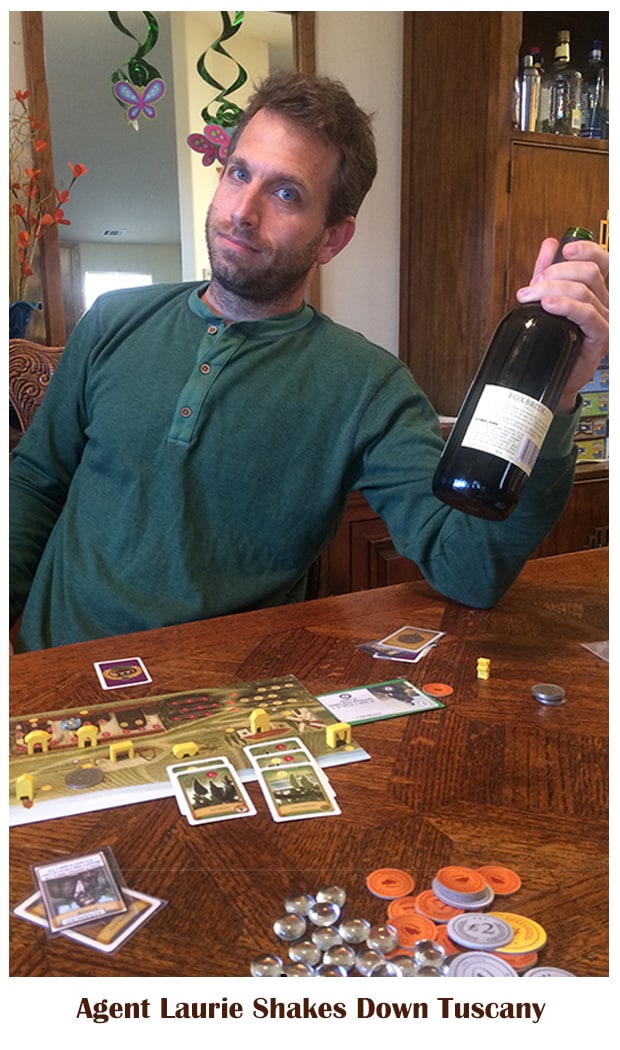
Meeting in an undisclosed location, deep in California’s wine country, three members of the League of Gamemakers joined forces to do a rigorous playtest of Tuscany: Expand the World of Viticulture in four back-to-back games. The fate of thousands of Kickstarter backers was in our hands. Our mission: Determine if Tuscany is truly the amazing expansion it appears to be, to advise Stonemaier Games of issues that can only be detected with our secret Gamemaker powers, and to bring the results of these tests to you.
The League was working with top secret prepublished print-and-play prototypes, including some classified components, so it is important to note that some aspects of the game may change prior to print.
The following analysis has been declassified.
ANALYSIS OF LUKE LAURIE:

Viticulture is a worker placement game with a richly-embedded theme, beautiful components, and interesting Euro-style gameplay. Stonemaier Games has recently launched a Kickstarter that gives you the chance to get the original game and the new expansion, which offers not just one new way to play, but hundreds of combinations of new rules, components, add-ons, and variants. This is Tuscany.
Tuscany is the Costco of expansions. The designer, Jamey Stegmaier, has said something like “Tuscany completes the world of Viticulture.” Imagine if the first expansion to Dominion came out, and it included Intrigue, Seaside, Prosperity, Alchemy, and Dark Ages all in one. It’s pretty much like that. Tuscany: Expand the World of Viticulture. A new board, a bunch of new meeples, new cards, and several new mechanics enrich the game. It has tons of options. Did I say it was huge?
Tuscany Legacy
Due to the breadth of the new options, Tuscany is divided into 3 tiers, the elements of which are intended to be integrated gradually. (Warning: do not attempt to use all of the elements of Tuscany at once. The effects are basically the same as crossing the streams. “It would be bad.”) The intent is for the elements to be added for each new game as part of a Legacy concept. For our playtests, the League accelerated the addition of new elements.
Tier 1 integrated seamlessly into the base game and added some nice options for a more dynamic experience, without requiring much of a learning curve. In just a few minutes, we added new components and were playing a richer game. Tier 1 reminded me of the seamless integration of one of the best expansions to date, the expansion to Kingsburg (To Forge a Realm). Highlights included the Mamas and Papas which provided variable starting resources, “Advanced Visitors” that gave more utility and flexibility, and a new mechanic for mortgaging unused fields for an influx of cash.
Tier 2 changed the game in a much bigger way, and required more significant adjustments to how one plans strategy. With the Tuscany board coming in, I gravitated quickly towards the area control mini-game in the corner, the influence map. I loved how I could gain a small benefit on the influence map, while also positioning myself for victory points later in the game. The structures cards opened up whole new strategic options as well, but require early commitment to pay off.
I will suggest one change to Tuscany. I’d like to see the Patrons worth more victory points. The Patrons are “secret mission” cards and provide you with a bonus for achieving a certain threshold, sometimes relative to you opponents. Examples include: “fewest workers”, “fewest structures”, and “at least 4 residual”. Patrons can be a nice way of creating uncertainty about who is winning toward the end of the game, and creating that tension and excitement – except they’re only worth 2 points. In some cases, the Patron goal obligates a player to make a dramatic shift in strategy to achieve the Patron’s objective. Consequently, we found that one of the best strategies was to ignore your Patron’s goal, and hope you achieved the goal anyway.
I can’t say I liked everything about Tuscany. I didn’t have to like everything. With Dominion, I’m not a fan of Dark Ages. But my least favorite parts about Tuscany turn out to be other people’s favorites, and that’s a huge strength of this expansion. You can customize your game to use exactly what you want, and find the vintage that fits your style.
I really, really enjoyed this game, and could see a tremendous value in the vast options provided by the expansion. I’d like to see more games take this kind of approach(more is better) to building expansions.
ANALYSIS OF JEFF CORNELIUS
When the league met recently to put Tuscany through it’s paces, I had never been exposed to Viticulture. I got to know Jamey through his fantastic blog posts and Kickstarter lessons. Many of which I incorporated into my own Kickstarter project. I was really excited to try out his game and to see what more I could learn. And I was not disappointed!
Viticulture is a rich game full of great nuances and fantastic decision opportunities. It is probably the tightest, most well-balanced game I have ever experienced. But, we’re not here to talk about Viticulture; we’re here to talk Tuscany.
Before I get into each tier of Tuscany, I want to point something out. When I first experienced Tuscany, I was expecting the same richness and integration of a beautiful theme as is found in Viticulture. I felt that my experience was a little lacking in this aspect. I strongly believe that this richness of theme is contained in Tuscany; however I believe that I missed out because of the way we added the expansions (4 at a time). As stated earlier, the game is meant to “uncork” slowly over the course of many plays. This is done to ease the players’ integration of numerous new mechanics. I am convinced that this is also done to allow the richness of the theme to slowly come out with each new play. So, please (I cannot stress this enough), follow Jamey’s advice – add the expansion over the course of many plays. You will be glad you did.

Tier 1: Mamas & Papas, Property, Patronage, and Advanced Visitors
I really enjoyed the first tier, and these expansions integrate seamlessly with Viticulture. My favorite of the tier one expansions was Property. I liked having the ability to mortgage my fields for money early in the game. Also, the fact that the bonus for the “flip property” action space is 1 victory point makes it that much more exciting. One thing I would say about this expansion is that the additional cards/tiles you place on your fields felt a little clunky. I think this could easily be implemented with a small token of some kind to indicate that the field was mortgaged and not take up additional table space. But the mechanics of the expansion are top-notch and work well with the game.
Tier 2: New Visitors, Special Workers, Extended Board, and Structures
This tier of expansions is when a lot of complexity starts coming into the game. Again, this is not a bad thing. It’s just a reminder that if you open these up slowly you will have a much better experience. All these expansions work very well. It was noted by our group that a small number of the structures cards seem to be out of balance but I am sure that will be corrected before the game goes to print.
My favorite expansion here was definitely the Extended Board. I loved the ability to take actions in all four seasons! Also, the new way that the wake-up track is done is pure genius. It adds so much to the game, I think that once you open up this expansion you will never go back to playing with the basic board. I do have one minor issue with this board. That is the coin icon that is found on various action spaces as a bonus. Its meaning in the various spaces is inconsistent. On one space it means “gain 1 coin”, on another space it means “your action costs you 1 fewer coin”. While this doesn’t seem like much, I do believe that consistency in game design is key to learning and understanding. I am hoping that this will be corrected before going to print.
Tier 3: Aboriculture, Formaggio, and Mafia
Since tier 3 expansions are only meant to be played one at a time (no matter how many are uncorked), we chose only one to play. We decided on the Mafia expansion due to the ease of learning it and the time we had to play. Mafia adds a fun little mini-game within the world of Tuscany. It does, however, make for some interesting decisions on where you place your grande worker and when you place it as well. I felt it was light enough to give us exactly what we wanted at the time and still added to the game.
I am looking forward to when I get to play again and try out the Aboriculture and Formaggio expansions.
ANALYSIS OF PETER VAUGHAN:
Ambassador to Tuscany
I’ve been to Tuscany a few times now (sadly only metaphorically in game world), as I have been part of Stonemaier’s ambassador program during the last year. I enjoy introducing folks to games, mine or other great titles I find along the way and I have been teaching Viticulture since my wife and I first played.
I mention that because upfront I can tell you that I enjoy this game, I will recommend it to you, and am currently backing the KS as fully as possible. That being said, I’ll keep it honest about all the reactions to this expansion pack.
A fun Viticulture fact: I got to know fellow leaguer Luke Laurie much better over a game of Viticulture that I ran at Strategicon Gateway 2013. So you might say that Viticulture has contributed in its own way to this league.
Hard core gamer tested!
I’ve been on a mission specifically to expose this game to core gamers who know how to break games and put them through their paces. My tests have included a tier 1 game with leaguers Brad Brooks, Mark Major and Christina Major and 1 partial tier 2 game with my friend Jon Geibel who excels at distilling the core (and victory path) of any game, especially worker placement types. Jeff and Luke are designers too and understand this category of games well so I was excited for this “Day of Tuscany” experience. (It reminded me of the full gaming days of Risk non-stop!)
To my surprise, the basic game of Viticulture, even second edition printing, is not entirely core gamer approved in my experience. It is however, spouse approved, which is saying something considering all the games I’ve brought into my home. Many introductions to Viticulture have left gamers feeling the tight victory point fulfillment cycle has too many bottleneck points and economy balance issues make the game feel somewhat incomplete. Despite that, I think the base game has gotten a serious amount of respect for a couple of factors:
- a relaxing, immersive game. Sure, the gameplay is tight, but the process of making wine is done at an enjoyable pacing. The theme and mechanics are presented so beautifully with custom components.
- very competitive gameplay. The last couple turns always come down to a few points. The game turns always come out to about the same time. This is designed well. If you think about games like Power Grid, tracks exist to reward the person in last place to avoid a runaway leader. This game doesn’t need that – it’s always a close race.
- solid worker placement, despite the few tweaks needed. If anything, the brunt of debate comes over the visitor cards and their usefulness at all points in the game, and this issue in particular has been completely covered in Tuscany.
Uncorking Tuscany
So does the Tuscany expansion pack solve these real or perceived limitations found in Viticulture for the core gamer? In my mind, it does. It completes this game fully for all types of players. It adds a ton of production value. It is now one of the most immersive non RPGs experiences I will own on my game shelf, and begs to be played with both casual and core players alike, with wine and cheese.
When I cracked into my first full game of Tier 2 expansions, I knew this game became serious. (as if it wasn’t before?) I mean it was more of a game for me and less of a game for my casual gamer friends. The depth of the game is fantastic! Area control, deck building, worker placement, bluffing (in tier 3). It got very deep. I didn’t win a single game of the Tuscany match-ups played, but I enjoyed every moment of the experience, and am thirsty for more.
A couple of stats I want to share from our games. Games seem to start out at 120 min for new players but come down to 90 min as ppl ‘get the game’ back up to a max of 180 min in tier 2 with all the moving parts. After understanding tier 2 better, our Tier 3 game came back in at at little over the 90 min norm. It’s consistent, but I agree with Jeff that you should probably enjoy Tuscany a sip at a time. Jamey actually covered a few uncorking styles in Tuscany Update #8 here. I would argue that you could introduce most of tier 1 together without any issue, and then spread out tier 2 and 3. That’s how I’d play.
For us, every single Tuscany game ended at 7 game turns (years of winemaking). When you think about that with all the moving parts, it’s amazing how well balanced the game is. The scores were close too! Ok, the tier 2 game saw a huge spike from Luke (he raked in 21 points in the final year after spending the first 4 years at 0 or -1 score, clearly he had a late game strategy), but otherwise all games were tight races. The point is, and designers should appreciate this most, imagine if you made a game, and then added 11 more experiences to that game, and found that all of them, no matter how mixed, ended in similar scores? You’d think – well that is a well designed game! And Tuscany is.
Final Scoring
Gift a copy of Viticulture to a casual/social gamer you know (bonus if they appreciate wine) to spread the love of games, grab another Viticulture and Tuscany for you at home, for both family and hard core game nights.
Jamey Stegmaier has called this game experience a sandbox, and I think that fits it well. Once you own it, you can play the parts you enjoy. Take it slow and easy and savor the winemaking, or throw it all in for a game where you don’t even need to make a bottle of wine to score big! Tuscany‘s game owners may all need to become GMs, blending story elements and hard core mechanics to each crowd. But that’s a small price to pay for the game host – owning a game that will cater to every gamer type you know!








